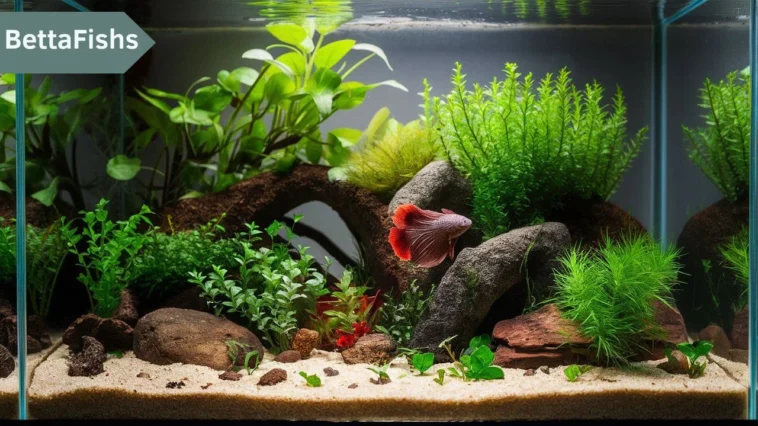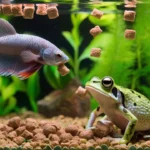Betta fish are undeniably beautiful creatures, often the centerpiece of many home aquariums. However, their beauty comes with a complex and sometimes challenging temperament, especially in males. Male bettas are known for their territorial nature and can exhibit aggressive behavior towards other fish.
This behavior often makes people wary of adding tank mates to a betta’s environment. But with careful planning and the right choices, your male betta can share his home with others. In this article, we’ll dive deep into understanding the nuances of betta behavior and explore the “What fish can live with Betta fish male?”.
Betta Fish Aggression
Nature of Male Betta Fish
Male bettas are territorial by nature. In the wild, these fish often establish a small territory that they defend fiercely. This territorial instinct is why male bettas are often seen flaring their gills and spreading their fins when they feel threatened or when another male betta is nearby.
Why Betta Fish Are Aggressive
Betta fish aggression stems from their evolutionary background. In the wild, bettas are found in shallow rice paddies, ponds, and slow-moving streams in Southeast Asia. Resources like food and space can be limited, so bettas have evolved to protect what they consider theirs. When confined in a tank, this instinct remains strong, making them protective of their space.
Identifying Aggression in Betta Fish
Recognizing signs of aggression is crucial to maintaining a peaceful tank. Look for behaviors such as flaring, chasing, or nipping at other fish. If your betta is displaying these signs, it may indicate stress or that the tank mate is not a good fit.
Ideal Tank Conditions for Betta Fish and Their Mates
Tank Size and Setup
When considering tank mates for your betta, tank size is paramount. A small tank can exacerbate aggressive behavior due to limited space. A minimum of 10 gallons is recommended, allowing enough room for both the betta and its companions to establish their own territories.
Water Parameters
Betta fish thrive in water temperatures between 76°F and 82°F, with a pH range of 6.5 to 7.5. When selecting tank mates, choose species that can tolerate similar conditions. Sudden changes in water quality can stress your betta, so regular monitoring and maintenance are essential.
Hiding Spots and Territory
Adding plants, rocks, and decorations to your tank can create hiding spots and break the line of sight, reducing the chances of aggression. These additions provide refuge for tank mates and help your betta feel secure in its territory.

Top 10 Fish That Can Live with Male Betta Fish
Corydoras Catfish
Behavior and Compatibility
Corydoras catfish are peaceful bottom dwellers that mind their own business, making them excellent tank mates for bettas. They are social fish that prefer to be in groups, so consider keeping at least three or more together.
Care Requirements
Corydoras thrive in water temperatures similar to bettas and enjoy a sandy substrate where they can forage. They require clean water and regular feedings of sinking pellets or wafers.
Neon Tetras
Behavior and Compatibility
Neon tetras are small, peaceful fish known for their vibrant colors. They swim in schools and tend to stay in the mid to upper levels of the tank, away from the betta’s territory.
Care Requirements
Neon tetras prefer slightly acidic water and temperatures around 74°F to 78°F. A school of at least six is recommended to keep them stress-free.
Kuhli Loaches
Behavior and Compatibility
Kuhli loaches are eel-like fish that spend most of their time hiding under substrate or decor. Their nocturnal nature and peaceful temperament make them good companions for bettas.
Care Requirements
Kuhli loaches prefer a soft substrate like sand and need plenty of hiding spots. They thrive in water temperatures between 75°F and 86°F.
Harlequin Rasboras
Behavior and Compatibility
Harlequin rasboras are small, peaceful fish that swim in schools. They are known for their striking black and orange coloration and are generally non-aggressive.
Care Requirements
Harlequin rasboras do well in slightly acidic to neutral water with temperatures between 72°F and 81°F. A group of six or more is ideal for these social fish.
Ember Tetras
Behavior and Compatibility
Ember tetras are tiny, peaceful fish that add a splash of color to your tank. Their small size and non-aggressive nature make them suitable companions for bettas.
Care Requirements
These fish prefer slightly acidic water and temperatures between 73°F and 84°F. To make sure they feel comfortable, keep them in groups of no fewer than six.
Otocinclus Catfish
Behavior and Compatibility
Otocinclus catfish, or “Otos,” are small algae eaters that stick to the sides of the tank or decor. Their peaceful nature and different dietary needs make them a safe choice for betta tanks.
Care Requirements
Otos need a well-established tank with plenty of algae to graze on. They prefer water temperatures between 72°F and 82°F.
Ghost Shrimp
Behavior and Compatibility
Ghost shrimp are transparent, small, and relatively hardy invertebrates. They tend to stay at the bottom of the tank, scavenging for food and are generally ignored by bettas.
Care Requirements
Ghost shrimp need clean, well-oxygenated water and temperatures between 65°F and 82°F. Ensure that your betta is not overly aggressive before introducing shrimp, as they can become a target.
African Dwarf Frogs
Behavior and Compatibility
African dwarf frogs are fully aquatic and can coexist with bettas due to their docile nature. They are active and interesting additions to any tank.
Care Requirements
These frogs prefer a warm environment with temperatures between 75°F and 82°F. They need a secure lid on the tank to prevent escapes and should be fed a diet of frozen or live food.
Pygmy Corydoras
Behavior and Compatibility
Pygmy corydoras are small, peaceful fish that stay near the bottom of the tank. Their shy and non-aggressive nature makes them a great choice for betta tanks.
Care Requirements
These fish thrive in water temperatures between 72°F and 79°F and prefer a sandy substrate.
Groups consisting of six or more should be maintained.
Cherry Shrimp
Behavior and Compatibility
Cherry shrimp are colorful, small shrimp that can add vibrancy to your tank. They are peaceful and spend most of their time foraging.
Care Requirements
Cherry shrimp prefer water temperatures between 70°F and 80°F and need plenty of hiding spots to feel safe. They can be sensitive to water quality, so regular maintenance is crucial.

Fish to Avoid Keeping with Male Betta Fish
Guppies
Guppies are often too colorful and active, which can trigger aggression in bettas. Male bettas may mistake guppies for rivals due to their bright colors and flowing fins.
Other Male Bettas
Male bettas are highly territorial and should never be kept together in the same tank. They will fight, often to the death, if placed in the same space.
Large or Aggressive Fish
Avoid large or aggressive species like cichlids or tiger barbs, as they can stress out or harm your betta. These fish may also compete for territory, leading to conflict.
Conclusion
Betta fish are undoubtedly stunning creatures, but their aggressive nature can make finding suitable tank mates challenging. However, with careful planning and the right environment, it is possible to create a peaceful community tank that includes a male betta. By understanding your betta’s behavior, choosing compatible species, and introducing them properly, you can enjoy a diverse and harmonious aquarium.
FAQs
Can Female Bettas Live with Male Bettas?
Female bettas can live with male bettas under certain conditions, such as in a large, well-planted tank with plenty of hiding spots. However, it’s crucial to monitor them closely for signs of aggression.
What Are the Best Plants for a Betta Fish Tank?
The best plants for a betta tank include Java fern, Anubias, and Amazon sword. These plants provide hiding spots and help create a natural environment for your betta.
How Many Fish Can I Keep with My Betta?
The number of fish you can keep with your betta depends on the tank size and the species chosen. A general rule is to start with a few compatible fish and monitor the betta’s behavior before adding more.
What Other Tank Inhabitants Can Live with Bettas?
In addition to fish, snails, and shrimp can also be good tank mates for bettas, provided they are introduced carefully and the betta is not overly aggressive.
Can Betta Fish Live in a Community Tank?
Betta fish can live in a community tank with the right tank mates and conditions. It’s essential to choose peaceful, non-aggressive species and provide plenty of space and hiding spots.





One Comment
Leave a ReplyOne Ping
Pingback:How many Betta fish can live together?